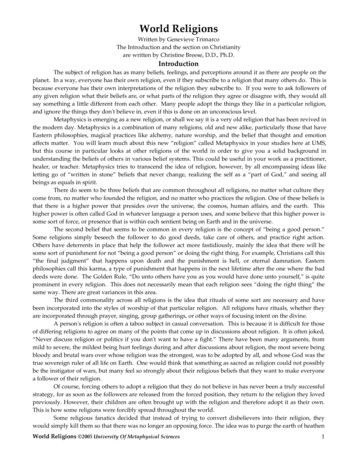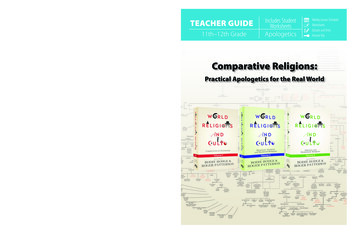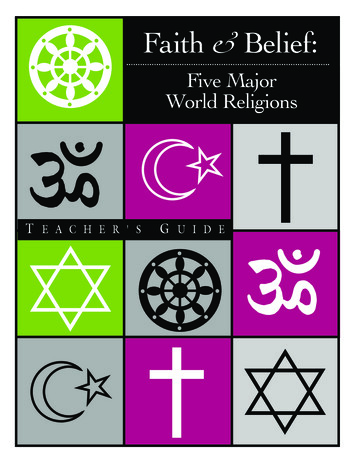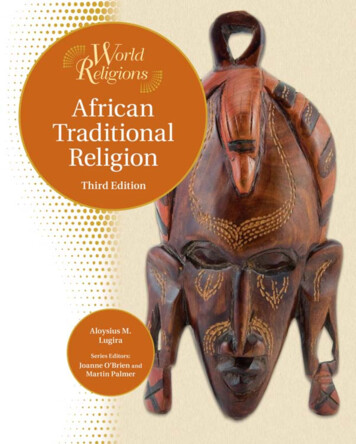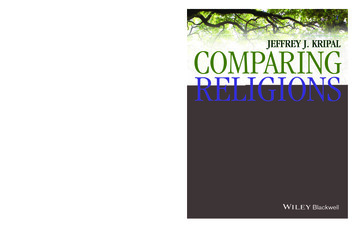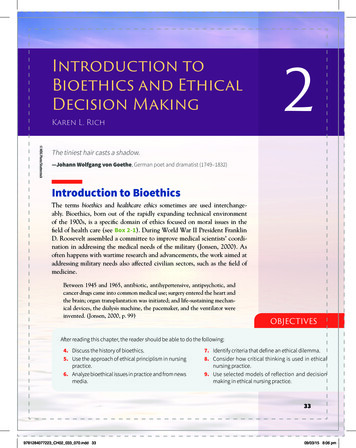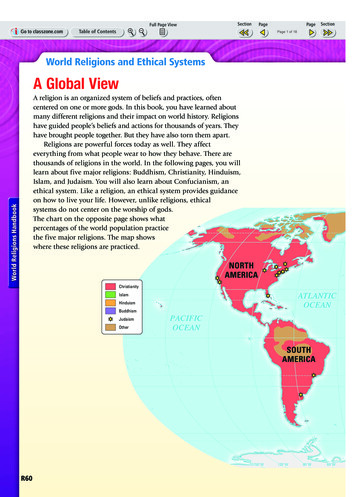
Transcription
Page 1 of 18World Religions and Ethical SystemsA Global ViewA religion is an organized system of beliefs and practices, oftencentered on one or more gods. In this book, you have learned aboutmany different religions and their impact on world history. Religionshave guided people’s beliefs and actions for thousands of years. Theyhave brought people together. But they have also torn them apart.Religions are powerful forces today as well. They affecteverything from what people wear to how they behave. There arethousands of religions in the world. In the following pages, you willlearn about five major religions: Buddhism, Christianity, Hinduism,Islam, and Judaism. You will also learn about Confucianism, anethical system. Like a religion, an ethical system provides guidanceon how to live your life. However, unlike religions, ethicalsystems do not center on the worship of gods.The chart on the opposite page shows whatpercentages of the world population practicethe five major religions. The map showswhere these religions are RICA150 WR60120 W90 W60 W30
Page 2 of 18World Population’s Religious AffiliationsWorld population: 6.2 billion (estimated 2002 figure)0.2% Judaism6% istianity20%IslamSource: World Almanac 2003ARCTIC OCEANArctic Circle60 NASIAEUROPE30 NICN0 WTropic of CancerPACIFICOCEANAFRICAEquator0 INDIANOCEANNWAUSTRALIAETropic of Capricorn30 SS00100010002000 miles2000 kilometers60 SAntarctic CircleANTARCTICA30 W0 30 E60 E90 E120 E150 EWORLD R ELIGIONS AND ETHICAL SYSTEMS R61
Page 3 of 18BuddhismBuddhism began in India in the sixth century B.C. The religion wasfounded by Siddhartha Gautama (sihd DAHR tuh GOW tuh muh),who came to be known as the Buddha. Buddha means “enlightenedone.” He was born into a noble family but left home to search forenlightenment, or wisdom. The Buddha is said to have achievedenlightenment after long study. According to Buddhist tradition,he taught his followers that the way to end suffering was bypracticing the Noble Eightfold Path. This path involved observingthe following: right opinions, right desires, right speech, right action,right job, right effort, right concentration, and right meditation.After the Buddha’s death, Buddhism spread in India, Ceylon,and Central Asia. Missionaries spread the faith. Buddhist ideasalso traveled along trade routes. The religion, however, did notsurvive on Indian soil. Today, most Buddhists live in Sri Lanka MonksBuddhist monks dedicate their(formerly Ceylon), East Asia, Southeast Asia, and Japan. BuddhaStatues of the Buddha, such asthis one in Japan, appearin shrines throughoutAsia. Buddhists try tofollow the Buddha’steachings by meditating,a way of emptying themind of thought. They alsomake offerings at shrines,temples, and monasteries.R62entire life to the teachings ofthe Buddha. They live togetherin religious communitiescalled monasteries. There, themonks lead a life of poverty,meditation, and study. Inthis photograph, Buddhistmonks in Myanmar hold theirbegging bowls.
Page 4 of 18Learn More About BuddhismSymbol The Buddha’s teaching, known as the dharma,is often symbolized by a wheel because his teaching wasintended to end the cycle of births and deaths. The Buddha issaid to have “set in motion the wheel of the dharma” duringhis first sermon. PilgrimageFor centuries, Buddhists have come to visitplaces in India and Nepal associated with theBuddha’s life. These sites include the Buddha’sbirthplace and the fig tree where he achieved hisenlightenment. Worshipers also visit the site ofthe Buddha’s first sermon, shown here.The Buddha called his insight into the nature ofsuffering the Four Noble Truths (see page 234).In the following selection, the Buddha tells hisfollowers how they can end suffering and findenlightenment. The path involves understandingthat life on Earth is brief and full of sadness. Italso involves giving up selfish desire.All created things are transitory [shortlived]; those who realize this are freed fromsuffering. This is the path that leads to purewisdom.All created beings are involved in sorrow;those who realize this are freed fromsuffering. This is the path that leads to purewisdom.All states are without self; those who realizethis are freed from suffering. This is the paththat leads to pure wisdom.from the DhammapadaTranslated by Eknath EaswaranChapter Connection For more about Buddhism, seeChapter 7.WORLD R ELIGIONS AND ETHICAL SYSTEMS R63
Page 5 of 18ChristianityChristianity is the largest religion in the world, with about 2 billionfollowers. It is based on the life and teachings of Jesus, as described inthe Bible’s New Testament. Jesus, a Jew, taught many ideas from theJewish tradition. Some biblical prophets had spoken of a day when apromised figure would come to save all of humankind. By the end ofthe first century A.D., many Jews and non-Jews had come to believethat Jesus was the one who would make this happen. Now called“Christians,” they spread their faith throughout the Roman Empire.Christians regard Jesus as the Son of God. They believe thatJesus entered the world and died to save humanity. Easter and Palm SundayOn Easter, Christians celebrate their belief in Jesus’ resurrection, or his being raisedto heavenly life after he was put to death. The Sunday before Easter, Christiansobserve Palm Sunday. This day celebrates Jesus’ triumphal entry into Jerusalem.Palm branches, like those carried here, were spread before him.R64
Page 6 of 18Learn More About ChristianitySymbol Jesus was crucified, or put to death on a cross. As aresult, the cross became an important symbol of Christianity. Itrepresents the belief that Jesus died to save humanity. Jesus and the DisciplesJesus’ followers included 12 disciples, or pupils.Jesus passed on his teachings to his disciples.This painting from the 1400s shows Jesus withhis disciples. St. PaulSt. Paul was one of the apostles who spreadChristian beliefs throughout the Roman Empire.Paul started churches almost everywhere hewent. Many churches today, such as this greatcathedral in London, are named for this apostle.One of Jesus’ most famous sermons is the Sermonon the Mount. In this talk, Jesus provided guidanceto his followers. His words were written downin the New Testament, the part of the Bible thatdescribes the teaching of Jesus Christ. In thefollowing verses, Jesus explains that people canbe saved by opening their hearts to God and bytreating others as they would like to be treated.“Ask, and it will be given you; seek, and youwill find; knock, and it will be opened toyou. For every one who asks receives, andhe who seeks finds, and to him who knocksit will be opened. Or what man of you, ifhis son asks him for a loaf, will give him astone? Or if he asks for a fish, will give hima serpent? If you then, who are evil, knowhow to give good gifts to your children,how much more will your Father who is inheaven give good things to those who askhim? So whatever you wish that men woulddo to you, do so to them; for this is the lawand the prophets.”Matthew 7:7–12Chapter Connection For more about Christianity,see Chapter 14.WORLD R ELIGIONS AND ETHICAL SYSTEMS R65
Page 7 of 18HinduismHinduism is a way of life guided by religious beliefs and practicesthat developed over thousands of years. Hindus believe that asupreme being called Brahman is the soul of the universe. The samepresence, they believe, can also be found within each person. Peoplecan be freed from suffering and desires once they understand thenature of Brahman. The religious practices of Hindus include prayer,meditation, selfless acts, and worship of the various Hindu gods.Today, Hinduism is the major religion of India and Nepal. Italso has followers in Indonesia, Africa, Europe, and the WesternHemisphere. Festival of DiwaliDiwali, the Festival of Lights, is the most important festival in India.Diwali may have begun as a harvest festival in ancient India. Today, itmarks the beginning of the year for many Hindus. They celebrate thefestival by lighting candles and lamps, as shown in this photograph.R66
Page 8 of 18Learn More About HinduismSymbol This symbol represents the word Om (or Aum),which is used at the beginning and end of prayers. Om isthe most sacred syllable for Hindus because they believethat it is the basic sound of the world and that it containsall other sounds. GodsBrahman often takes the form ofthree gods in Hinduism. Brahmais the creator of the universe.Vishnu is its protector. Shiva isits destroyer. All three gods arerepresented in this sculpture. Brahmin PriestBrahmin priests, like the one shown here, areamong Hinduism’s religious leaders. These prieststake care of the holy images in temples and readfrom the religion’s sacred books.Hinduism has many sacred writings. The Vedas,four collections of prayers, rituals, and other sacredtexts, are the oldest Hindu scriptures. They arebelieved to contain all knowledge, past and future.The Bhagavad Gita is another important Hindutext. In this work, the god Vishnu takes on thepersonality of a chariot driver named Krishna.Krishna and the warrior Arjuna discuss the meaningof life and religious faith. In this selection, Krishnaexplains that Brahman cannot be destroyed.Weapons do not cut it,fire does not burn it,waters do not wet it,wind does not wither it.It cannot be cut or burned;it cannot be wet or withered;it is enduring, all-pervasive,fixed, immovable, and timeless.Bhagavad Gita 2:23–24Chapter Connection For more about Hinduism,see Chapter 7.WORLD R ELIGIONS AND ETHICAL SYSTEMS R67
Page 9 of 18IslamIslam is a religion based on the teachings of the Qur’an, the religion’s holybook. Followers of Islam, known as Muslims, believe that God revealedthese teachings to the prophet Muhammad through the angel Gabrielaround A.D. 610. Islam teaches that there is only one God—the same Godthat is worshiped in Christianity and Judaism. In Arabic, God is calledAllah. Muslims also believe in the prophets of Judaism and Christianity.In fact, Muslims traditionally refer to Christians and Jews as “people of thebook.” That is because Christians and Jews have received divine revelationsfrom scriptures in the Bible.Today, Muslims live in southwestern and central Asia and parts ofAfrica. Islam also has many followers in Southeast Asia. Muslims show theirdevotion by performing acts of worship known as the Five Pillars of Islam.These include faith, prayer, charity, fasting, and a pilgrimage to Mecca. The Dome of the RockThe Dome of the Rock in Jerusalem is one ofIslam’s holiest sites. The rock on the site is thespot from which Muslims say Muhammad roseto heaven to learn Allah’s will. With Allah’sblessing, Muhammad returned to Earth to bringGod’s message to all people. Muslim PrayerFive times a day—dawn, noon, midafternoon, sunset, and evening—Muslimsface toward Mecca to pray. Like the peoplein this photograph, Muslims stop what theyare doing when they hear the call to prayer.Everything comes to a halt—even traffic.R68
Page 10 of 18Learn More About Islam RamadanDuring the holy month of Ramadan, Muslims fast,or do not eat or drink, from dawn to sunset. Thefamily shown here is ending their fast. The mostimportant night of Ramadan is called the Night ofPower. This is believed to be the night the angelGabriel first spoke to Muhammad.Symbol The crescent moon has become a symbol ofIslam. The symbol may be related to the new moon thatbegins each month in the Islamic lunar calendar.The Qur’an is the spiritual guide for Muslims.It also contains teachings for Muslim daily life.The following chapter is called the Exordium(introduction). Muslims recite this short chapteras well as other passages from the Qur’an, whenthey pray.In the Name of God, the Compassionate,the MercifulPraise be to God, Lord of the Universe,The Compassionate, the Merciful,Sovereign of the Day of Judgment!You alone we worship, and to You alonewe turn for help.Guide us to the straight path,The path of those whom You have favored,Not of those who have incurred Your wrath,Nor of those who have gone astray.Qur’an 1:1–6WORLD R ELIGIONS AND ETHICAL SYSTEMS R69
Page 11 of 18JudaismJudaism was the first major monotheistic religion—that is, basedon the concept of one God. The basic teachings of Judaism comefrom the Torah, the first five books of the Hebrew Bible. Judaismteaches that a person serves God by studying the Torah and livingby its teachings. The Torah became the basis for the civil andreligious laws of Judaism. The followers of Judaism, or Jews, alsobelieve that God set down many moral laws for all of humanitywith the Ten Commandments.Today, there are more than 14 million Jews throughout theworld. Many live in Israel, where a Jewish state was created in 1948. AbrahamAccording to the Torah, God chose a Hebrew shepherd namedAbraham to be the “father” of the Hebrew people. In the 19thcentury B.C., Abraham led his family to a land that he believedGod had promised them. This painting illustrates their journey.R70
Page 12 of 18Learn More About JudaismSymbol The Star of David, also called the Shieldof David, is a very important symbol of Judaism. Thesymbol honors King David, who ruled the kingdomof Israel about 1000–962 B.C. RabbiRabbis are the Jewish people’s spiritual leadersand teachers. A rabbi often conducts the servicesin a synagogue, or Jewish house of worship.Like the rabbi shown here, he or she mayalso conduct the ceremony that marks Jewishchildren’s entrance into the religious community. Western WallMany Jews make the pilgrimage to the WesternWall, shown here. The sacred wall, also known asthe Wailing Wall, formed the western wall of thecourtyard of the Second Temple of Jerusalem. Thetemple was built in the second century B.C. TheRomans destroyed it in A.D. 70.The Book of Genesis is the first book of theHebrew Bible and of the Torah. Genesis tellsthe history of the Hebrew people. It focuses onthe individuals with whom God had a specialrelationship. In the following verses, God speaks toAbraham. His words express a promise of land anda special pledge to the Hebrew people.Now the Lord said to Abram [Abraham],“Go from your country and your kindredand your father’s house to the land thatI will show you. And I will make of youa great nation, and I will bless you, andmake your name great, so that you will bea blessing. I will bless those who bless you,and him who curses you I will curse; and byyou all the families of the earth will blessthemselves.”Genesis 12:1–3Chapter Connection For more about Judaism, seeChapter 10.WORLD R ELIGIONS AND ETHICAL SYSTEMS R71
Page 13 of 18ConfucianismConfucianism is an ethical system based on the teachings ofthe Chinese scholar Confucius. It stresses social and civicresponsibility. Confucius was born in 551 B.C., during a time ofcrisis in China. He hoped his ideas and teachings would restorethe order of earlier times to his society. But although Confuciuswas active in politics, he never had enough political powerto put his ideas into practice. After his death, Confucius’students spread his teachings. As a result, his ideas becamethe foundation of Chinese thought for more than 2,000 years.Today, Confucianism guides the actions of millions ofChinese people and other peoples of the East. It has alsogreatly influenced people’s spiritual beliefs. While EastAsians declare themselves to follow a number of religions,many also claim to be Confucians. TempleAlthough Confucianism has no clergy orgods to worship, temples, like this one inTaiwan, have been built to honor Confucius.In ancient times, the temples providedschools of higher education. Today, manyhave been turned into museums.R72
Page 14 of 18 ConfuciusConfucius believed that societyshould be organized around fivebasic relationships. These are therelationships between (1) rulerand subject, (2) father and son,(3) husband and wife, (4) elderbrother and junior brother, and(5) friend and friend.Learn More About ConfucianismSymbol The yin-and-yang symbol represents oppositeforces in the world working together. Yin represents allthat is cold, dark, soft, and mysterious. Yang representseverything that is warm, bright, hard, and clear. The yin-andyang symbol represents the harmony that Confucius hopedto restore to society.Confucius’ teachings were collected by his studentsin a book called the Analects. In the followingselections from the Analects, Confucius (called theMaster) instructs his students about living a moraland thoughtful life.The Master said: “Even in the midst ofeating coarse rice and drinking water andusing a bent arm for a pillow happinessis surely to be found; riches and honorsacquired by unrighteous means are to melike the floating clouds.” (7.16)The Master said: “When I walk with twoothers, I always receive instruction from them.I select their good qualities and copy them,and improve on their bad qualities.” (7.22) Confucius’ BirthdayHistorians do not know for certain the daywhen Confucius was born, but people in EastAsia celebrate his birthday on September 28.In Taiwan and China, it is an official holidayknown as Teachers’ Day. The holiday paystribute to teachers because Confucius himselfwas a teacher. Here, students in Beijing takepart in a ceremony honoring their teachers.The Master said: “The people may bemade to follow something, but may not bemade to understand it.” (8.9)from the AnalectsTranslated by Raymond DawsonChapter Connection For more about Confucianism,see Chapter 8.WORLD R ELIGIONS AND ETHICAL SYSTEMS R73
Page 15 of 18Other Important ReligionsYou have learned about the five major world religions. Now findout about some other important religions: Bahaism, Shinto,Sikhism, and Zoroastrianism. These religions are important bothhistorically and because they have many followers today. ShintoShinto, meaning “way of the gods,”is Japan’s oldest and only nativereligion. Shintoists worship manygods, called kami. They believe thatkami are spirits found in mountains,rivers, rocks, trees, and other partsof nature. Shintoists often worshipthe kami at shrines in their homes.They also celebrate the gods duringspecial festivals, such as the oneshown here. Today, there are about3 million Shintoists, mostly in Japan. BahaismBahaism (buh HAH IHZ uhm) is a youngreligion, with more than 7 million followersthroughout the world. It was founded in 1863in Persia (modern-day Iran) by a man known asBahaullah, which means “splendor of God” inArabic. Followers believe that, in time, God willmake barriers of race, class, and nation breakdown. When this happens, people will form asingle, united society. All of the Baha’i housesof worship have nine sides and a central dome,symbolizing this unity. The Baha’i house ofworship shown here is located in Illinois.R74
Page 16 of 18 SikhismSikhism (SEEK IHZ uhm) was founded in Indiaover 500 years ago by Guru Nanak, a man raisedin the Hindu tradition. The religion’s 24 millionfollowers, called Sikhs, believe in one God. LikeBuddhists and Hindus, Sikhs believe that the soulgoes through repeated cycles of life and death.However, Sikhs do not believe that they have tolive outside the world to end the cycle. Rather,they can achieve salvation by living a good andsimple life. Uncut hair symbolizes this simplelife. Many Sikh men cover their long hair with aturban, like the one worn by the man here. ZoroastrianismZoroastrianism (ZAWR oh AS tree uh NIHZ uhm)was founded in ancient Persia around 600 B.C.by a prophet named Zoroaster. This prophettaught that Earth is a battleground where agreat struggle is fought between the forcesof good and the forces of evil. Each personis expected to take part in this struggle. Atdeath, the Zoroastrian god, called Ahura Mazda(ah HUR uh MAZ duh), will judge the personon how well he or she fought. This stone reliefshows Ahura Mazda (right) giving the crownto a Persian king. Today, there are about 2.5million Zoroastrians throughout the world.WORLD R ELIGIONS AND ETHICAL SYSTEMS R75
Page 17 of 18Comparing World Religionsand Ethical ismIslamJudaismConfucianism364 million2 billion828 million1.2 billion14.5 million6.3 millionName ofgodno godGodBrahmanAllahGodno godFounderthe BuddhaJesus Christno one founderno founderbut spread byMuhammadAbrahamConfuciusHoly bookmany sacredbooks,including theDhammapadaBible, includingOld Testamentand NewTestamentmany sacredbooks, includingthe BhagavadGitaQur’anHebrew Bible,including theTorahAnalectsClergyBuddhist monkspriests,ministers,monks, andnunsBrahmin priests,monks, and gurusno clergy but ascholar class,called theulama, andimams, who maylead prayersrabbisno clergyBasicbeliefs Followerscan achieveenlightenment byunderstandingthe Four NobleTruths and byfollowing theNoble EightfoldPath of rightopinions, rightdesires, rightspeech, rightaction, rightjobs, righteffort, rightconcentration,and rightmeditation. There is onlyone God, whowatches overand cares forhis people. The soulnever dies but iscontinually rebornuntil it becomesenlightened. There is onlyone God, whowatches overand cares for hispeople. Jesus Christis the Son ofGod. He died tosave humanity.His death andresurrectionmade eternallife possible forothers. Persons achievehappiness andenlightenmentafter they freethemselves fromtheir earthlydesires. Personsachievesalvation byfollowing theFive Pillars ofIslam and livinga just life. Thepillars are faith,prayer, charity,fasting, andpilgrimage toMecca. Social order,harmony,and goodgovernmentshould be basedon strong familyrelationships.(estimated2003 figures) Freedom fromearthly desirescomes frommany lifetimesof worship,knowledge, andvirtuous acts. God lovesand protects hispeople but alsoholds peopleaccountable fortheir sins andshortcomings. Persons serveGod by studyingthe Torah andliving by itsteachings. Respectfor parentsand elders isimportant to awell-orderedsociety. Education isimportant for thewelfare of boththe individualand society.Source: World Almanac 2004R76
Page 18 of 18ReviewMAIN IDEASBuddhism (pages R62–R63)1. How did the Buddha believe that hisfollowers could end their suffering?2. How did Buddhism spread?Christianity (pages R64–R65)3. Why is Jesus Christ important to theChristian religion?4. What are some Christian beliefs?Standards-Based AssessmentInterpreting a Pie Chart The pie chartbelow shows what percentages of thepopulation of India practice the majorreligions. Use the pie chart to answer thefollowing questions.India’s Religious AffiliationsPopulation: 1.1 billion (estimated 2003 figure)1% Buddhism2% Christianity3% OtherHinduism (pages R66–R67)5. What is the importance of Brahman inHinduism?6. What three gods does Brahman oftentake the form of?Islam (pages R68–R69)7. How do Muslims believe the teachingsof the Qur’an were revealed?8. Why do Muslims traditionally refer toChristians and Jews as “people of thebook”?Judaism (pages R70–R71)9. What does it mean to say that Judaismis a monotheistic religion?10. What are the Ten Commandments?Confucianism (pages R72–R73)11. What did Confucius hope to restore?12. What five relationships are important inConfucianism?Other Important Religions (pages R74–R75)13. How does Shinto differ from Bahaism,Sikhism, and Zoroastrianism?14. How is Sikhism similar to Buddhism andHinduism?12%Islam82%HinduismSource: World Almanac 20041. What percentage of the people inIndia practice Hinduism?A. 1 percentB. 2 percentC. 12 percentD. 82 percent2. Which religion is practiced by12 percent of the population?A. ChristianityB. HinduismC. BuddhismD. IslamCRITICAL THINKING15. COMPARING What goal do Buddhistsand Hindus have in common?16. DRAWING CONCLUSIONS How does Islamaffect the everyday lives of its followers?17. SUMMARIZING Which of the religionsyou have studied are monotheistic?Test PracticeClassZone.comAdditional Test Practice, pp. S1–S33WORLD R ELIGIONS AND ETHICAL SYSTEMS R77
In this book, you have learned about many different religions and their impact on world history. Religions have guided people’s beliefs and actions for thousands of years. They have brought people together. But they have also torn them apart.
